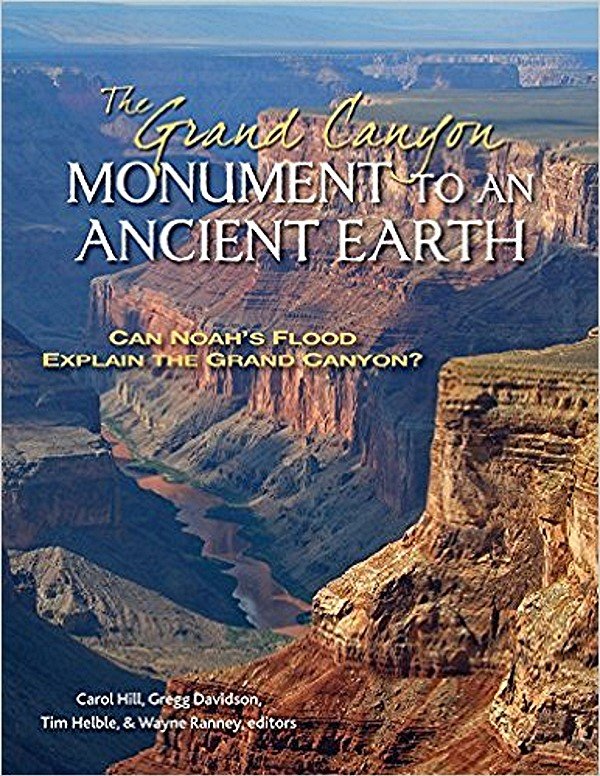Geology for evangelicals
In honor of the opening of Ken Ham’s nefarious Ark “replica” today – you know, the one made out of gopher steel and wood – I decided to post this piece about a book written by evangelical scientists who know better than to treat the book of Genesis as history or science, for evangelical laypersons who either know better than to treat the book of Genesis as history or science, or can be taught to know better.

The book is called The Grand Canyon: Monument to an Ancient Earth, and it is an anthology written by competent people and directed at evangelical Christians. Indeed, the subtitle is, “Can Noah’s Flood Explain the Grand Canyon?” The book, which I have not seen, appears to be lavishly illustrated, with 255 photographs and 104 diagrams and sketches, according to Church & State magazine. It is being sold in all 8 bookstores in the Grand Canyon National Park.
I am getting virtually all my information from an article in the latest issue of Church & State magazine. They note that the book has 11 co-authors, 8 of whom are evangelical Christians, and 3 are agnostics. The authors’ specialties include geology, biology, and paleontology. Church & State quotes Steven Newton of the National Center for Science Education to the effect that the book “does a great job of explaining the science of Grand Canyon’s spectacular geology, as well as helping readers understand how the creationist misuse of Grand Canyon finds no support from science.”
Importantly, the publisher of the book is an evangelical firm, Kregel Publications, which, according to co-author Tim Helble, “was a good match for us because they have … published other books dealing with origins issues and would be able to sell the book in venues where evangelicals can be reached.” The last seems very important to me.
The bulk of the Church & State article is an interview with Mr. Helble, a retired hydrologist with the National Weather Service. Mr. Helble states explicitly that the “11 authors wanted to help counter the misleading information being disseminated by the young-Earth creationist (YEC) ministries.” He recognized the problem in 1994 when he found a book, Grand Canyon: Monument to Catastrophe, edited by PhD geologist Steve Austin, and apparently chock full of errors. Here are a few snippets from the interview:
Three things we agreed to before we started writing were (1) our target audience is people who are uncertain about the age of the Earth, (2) a Christian reader shouldn’t feel like he/she is being ridiculed and (3) a college science degree shouldn’t be needed to understand it. …
Of course the Bible has tremendous value – I just think the young Earthers over-globalize the flood account, fail to see the worldview of the ancient Near East people and miss out on the rich poetic devices used in the early parts of Genesis. …
I think those claiming censorship misunderstand how the scientific process works. You can’t write an article about something like a geologic formation that basically says “the Flood did it,” and expect to have it accepted by a scientific journal. There has to be a quantitatively realistic mechanism consistent with the laws of physics behind what you are proposing. …
Creationism is a third rail in public schools, but there are some ways to inoculate students against it without directly addressing the subject. Schools could to do a better job of teaching how we know the Earth is old. For example, instead of just teaching that sedimentary rocks are made of sediments like sand and silt, students can be shown how fossils are found in such rocks of things that take a long time to form like intact reef systems, termite nests, forest communities and orderly nests of unhatched dinosaur eggs. …
By the way, when a student brings up young-Earth arguments, the worst thing to do is attack his or her faith. All you’re doing then is reinforcing the “us-vs.-them” mindset and helping the young-Earth ministries keep a lifetime follower. …
It certainly seems like there is a clash [between science and religion] if you focus on the extremes – the “new atheists” at one end and the YECs at the other. It’s interesting that both of them insist on a wooden, literal interpretation of Genesis 1-11.
I think religion and science can coexist if they don’t tread on each other’s turf where it’s not appropriate. I’ve seen new atheists use some pretty bad theology, and I think religious people should accept that there are some things that you just have to take on faith – stop trying to find “ultimate proofs” of difficult theological ideas like creation.
I am an old atheist (or, as I prefer to put it, a strong agnostic), and I do not know what is wooden about my interpretation of Genesis, but we will let that go. I think that among Mr. Helble’s most important remarks are that people should not feel that they are being ridiculed (yes, I know it is difficult at times, and the line between gentle satire and ridicule is sometimes uncertain), students should not think their faith is being attacked, and religion and science can coexist if they do not “tread on each other’s turf.” That is, as your local accommodationist, I think he is right that we have to accept religious people as they are, but only as long as they do not make claims that are flatly contrary to scientific fact.
